Yves here. I am publishing this post from John Helmer’s site in full, as usual. You will soon see it based substantially on what amounts to a two-part report by a foreign exchange trader. The first is a general discussion of the foreign exchange market and related markets, most importantly sovereign bond markets (FX rates are arbed though sovereign bond interest rate differentials), IMHO this is way overlong and I assume Helmer felt compelled to reproduce it in full out of deference to his contact.
As someone who consulted to the then world’s biggest trading FX desk, housed in Citibank’s London treasury, and later the then biggest FX option trader in the world, O’Connor & Associates, yours truly has picked up a few things about how these markets operate. And I therefore quibble about a lot of the material in his first section. For instance, he depicts Russia as a safe haven currency. Huh? A currency needs to be readily tradeable internationally to operate as a safe haven. The only place you can freely buy the Russian currency is on the Moscow Stock Exchange. Consistent with that, its ups and downs after recovering from the blow of the imposition of Collective West sanctions are explainable by trade, and to a degree also by central bank intervention. This have been a favorite topic of Alexander Mercouris. For instance, he pointed out when the rouble strengthened to over 60 to the dollar, it was due to trade flows, not investment flows, as in Russia continuing to have foreigners buy its oil (ultimately resulting in selling foreign currencies to buy roubles), while Russian imports had fallen sharply due to domestic substitution of European imports.
While yours truly has also pointed out that in general, foreign exchange transactions related to international capital flows greatly exceed those of transactions related to trade, the ratio and importance for a particular currency depends on how active and open its capital markets are to foreign investors. Russia has never been a big destination for foreign hot money investors.
The second part, focused on Israel, has very useful material on the collapse of Israel’s government revenues, which one can view as a not-bad proxy for the economy overall. However, the author also goes on about the Israel bond market. In most economies, unlike the US, the bulk of corporate finance is provided by bank loans (and also suppliers). The Israel bond market is so tiny at $200 million that a middling-sized private equity allocation from CalPERS would be able to buy a full year of issuance. That suggests to me that the main company funding action is not found there. This section also has some sour notes, which are presumably artifacts of not-careful drafting. For instance, at the start of this section, the author describes shekel weakness after October 7. In his list of causes he includes members of the diaspora sending dollars to cash-stressed family members in Israel. That would strengthen the shekel; the recipient would take the dollars received and sell them to buy local currency, which would tend to make it appreciate.
By John Helmer, the longest continuously serving foreign correspondent in Russia, and the only western journalist to direct his own bureau independent of single national or commercial ties. Helmer has also been a professor of political science, and an advisor to government heads in Greece, the United States, and Asia. He is the first and only member of a US presidential administration (Jimmy Carter) to establish himself in Russia. Originally published at Dances with Bears

The Axis of Resistance — that’s the Arab militaries with Iran and in the background, Russia – knows how to wage economic warfare against the US and its proxy, Israel. The Houthi sanctions on shipping, for example, are showing more effectiveness in stopping Israel-bound or Israel-linked vessels in the Red Sea than US sanctions have been to block Russian oil shipments.
In attrition war, on the economic front just like the Gaza and other fire fronts, the Axis of Resistance wins by maintaining its offensive capacities and operations for longer than the US and US-backed Israeli forces can defend. Like troops, tanks, and artillery pieces, the operational goal is to grind the enemy slowly but surely into retreat, then capitulation.
How to measure if this is happening now to the Israelis in the international money markets?
An international currency and bond trader answers by providing, first, a primer for each of the market indicators, and how to read them; and then a ready reckoner for the damage being done to Israel’s economic resources as those who operate in the money markets gauge their opportunity.
For making money, you see, the opportunity of capitalizing on Israel’s defeat may soon be more profitable than investing in its success. When the markets see this chance at profit-making, usually long before the politicians and their captive media acknowledge it, there is an inflection point in the flow of money. That does its damage, not by hitting the Israelis and Americans in their bunkers with bullets and bombs, but by moving the money the US-backed Israeli entity needs out of reach, and cutting them off, both the US and Israel, from market confidence that they can win their war, genocide or not.
The writer of this primer and money-market assessment has requested anonymity to protect against retaliation from the US, Israel or their allies.
 Primer for the money markets
Primer for the money markets
Understanding market indicators is crucial during prolonged conflicts. To forecast the outcome of the conflict, you need a gauge for how financial markets respond to the evolving geopolitical situation.
Contrary to the conventional wisdom, the foreign exchange (forex, currency) markets are the first markets to look at. There are the safe haven currencies: issuers from the strongest military countries – RUB (Russian Ruble), USD (United States Dollar), CNY (Chinese Yuan), and the currencies of the trading and financial hubs, CHF (Swiss Franc), GBP (British Pound), AED (United Arab Emirates Dirham). You can add others when they are appropriate in the circumstances of the war you are waging, defending, or betting on.
Then there are warzone or associated currencies: you must monitor the currencies of countries directly involved in or closely tied to the conflict. Currency depreciation may also signal economic problems developing under the fog of war – the EUR (European Union Euro), TRY (Turkish Lira), and ILS (Israeli Shekel). I don’t include the UAH (Ukrainian hryvnia) as it is now entirely dependent now on life-support by the US and EU (with the risk of hyperinflation). The market bids up the currencies of countries which are winning their wars, and bids down the currencies of those which are losing.
THE COLLAPSE OF UAH TO USD SINCE THE WAR BEGAN
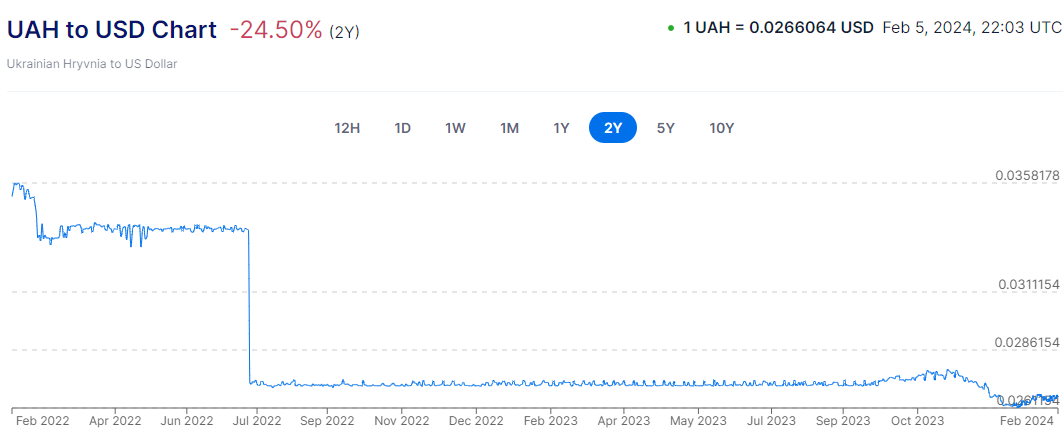
Source: https://www.xe.com/
Not everyone has access to the Reuters or Bloomberg databases which traders use. Do your own research to select your data feeds but this information has become widely available. The real-time data-feed providers charge premium prices. If you can live with delayed quotes or secondary market makers, much of the longer trend data is available today for free on the internet.
The intraday charts are more for professionals or traders having to move large positions. You should note the time of day when the bid/ask spread is the narrowest. That is when most traders are active on both sides of the trade. Weekends, after-business hours, or when decisive news from the battlefield is anticipated, the bid/ask spread widens or there are no prices being made. Let the buyer beware when there is no confidence in what will happen next. Astute traders exploit the arbitrage opportunities between the various markets which view the battlefield from different points of view and with different sources of information; in this game you must have big money and low transaction costs to play. .
The longer time period charts show underlying trends more clearly, as well as the currency support and resistance levels.
The forward market gives prices at fixed time intervals into the future; these are indeed wagers on the future. The spot market gives the parties two business days to settle the trade. Popular longer time periods are straight one week, one month, three months, six months, nine months, and one year.
Forward contract pricing is based on interest rate differences between the two markets. This is why you should start looking at the forex spot market first.
Many money market traders prefer to start with government bond markets. Russia and China are net creditor countries so their bonds are relatively thin or even not available due to sanctions. In order to move from one market to another (even in bonds) traders will have to move through the forex market, so I recommend starting here first. This is where most of the liquidity is.
Non-deliverable forwards (NDFs) . are the handy tool operated offshore to get around trading restrictions. NDFs are executed as swaps and are cash settled for the differences instead of the nominal amounts. In Europe most of these are settled in USD or EUR. For more info see this.
Next up is the bond market.
Government bonds: follow the yield the spread between short and long term rates. Government bonds are bought when other more risky assets are sold. This is to reduce third-party risk (if the money is on a bank account, the bank owes you the money — if you buy a government bond, the government owes you). Governments are insensitive to changes in market conditions. They will borrow as and when they need to, as well as to roll over previously issued debt. New issues, their amounts, and other details are usually published well in advance. Take note if the government you are following is borrowing in a foreign currency. This is acceptable in certain situations but is often a sign of weakness.
For a country in war, the more uncertain the outcome, the sharper the drop in the yield curve into the future. In the case of the Ukraine, as it loses its war, the more desperately it needs to borrow funds, and the shorter the period of time in which buyers of Ukrainian bonds will invest in order to make their profit. Note when the yield increases, the bond prices decline. UAH yields have had to increase sharply as the war progressed. Without the sharp yield increase the UAH bond would have been toilet paper. It still might become that.
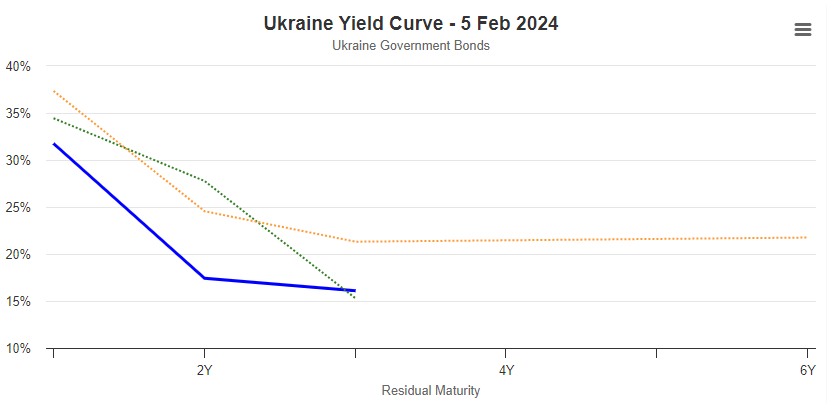
Source: https://www.investing.com/
When there is uncertainty in the markets, there is a flight to safety. Increased demand for safe-haven assets mean rising bond prices and lower yields. A sharp drop in yields is a signal that money is moving out of the declining, riskier market. It may be moving offshore into another currency. Large transactions are often spread out over time to keep a low profile, and mask the calculations of the big-money players from the smalltime bettors.
Corporate bonds: by monitoring the spreads between corporate and government debt you may be able to follow the way the market is calculating the risk between corporations and between corporations and governments. Defaults are a sign that businesses are struggling to sustain their revenues and meet their costs and debts. This is usually the signal for more market intervention from central banks, later from governments acting with fiscal instruments or regulatory and legal measures. The bond markets should be followed first because they are considerably bigger than stock markets, and harder in which to conceal expectations or rig values.
The stock market is best followed by a volatility index (VIX). This is also called the fear index — it measures the level of volatility in stock prices for the thirty-day period ahead. . This is the foundation of derivatives pricing. Increasing volatility often means that many traders will have decided to leave the market. This then increases the price spread and number and quantity of bids/offers. Such markets can be “pushed” (manipulated) often through derivative contracts.
VIX REACTS TO THE START OF THE UKRAINE WAR
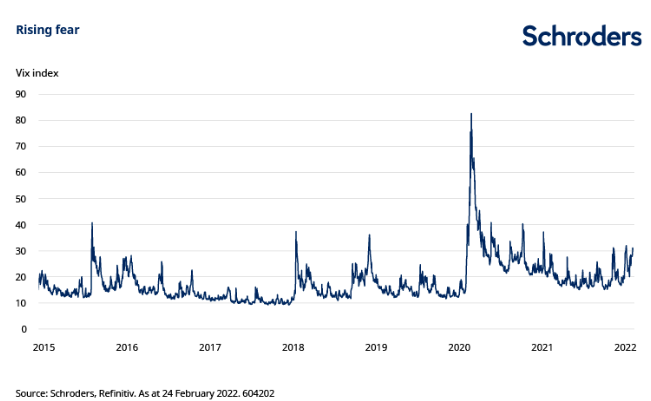
Analysis at source: https://www.schroders.com/
Conflict stocks are military, weapon, and ammunition suppliers which see higher demand during a prolonged war. If there is a shortage of a particular product or service needed by one of the belligerents and their suppliers refuse or cannot expand production /service, then you know the conflict is lost. This is actually the case for missile, tank, and artillery, as well as for 155-mm artillery shell manufacturers in the collective West. Following these stocks will show you the market sentiment on how the battlefield is going for one side or the other. Chinese and North Korean military providers are almost all state owned. They are difficult to follow and next to impossible to trade.
SHARE PRICE TRAJECTORIES OF THE MAJOR US, EUROPEAN ARMS MAKERS OVER THE COURSE OF THE UKRAINE WAR
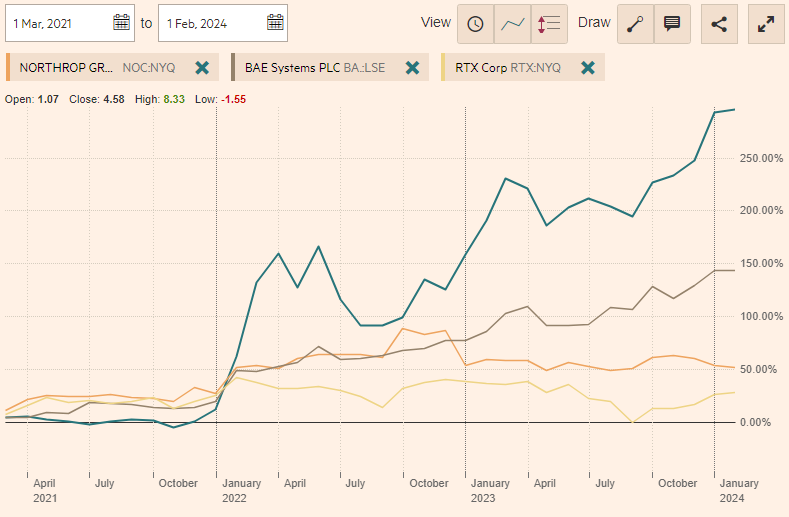
KEY: grey=Rheinmetall; green=BAE; orange=Northrup-Grumman; yellow=Raytheon (RTX). Source: https://markets.ft.com/
Commodities: All economies depend on energy. Geopolitical power is based on who controls it. Supply disruptions (Houthis) or concerns for global economic growth (EU deindustrialization) can lead to volatility in oil and gas markets (and then buyer’s markets).
Gold and precious metals: Often seen as safe-haven assets, the prices are often manipulated by derivative contracts. Statistics are not reliable (no audited statements from key players like the Federal Reserve). Refineries remelt bullion into different size bars. If they produce more measured in ounces or in kilograms for good delivery, you can guess whether the flow is west (collective West) or east (Russia, China). Mining and refining companies are often very well informed (it’s their business).
Trade Balances: Changes in trade balances indicate relative strengths often based on military muscle providing insight into how global commerce is affected by the conflict. Steel, aluminum, and concrete top the war indicator list. Strategic metals are the Achilles Heel for many purchasers. Shipping rates are also a good leading indicator.
PMI (Purchasing Managers’ Index): A decline in PMI may indicate economic contraction, influenced by the disruption caused by the prolonged war.
Sentiment surveys of these types will confirm whether the markets are calculating differently about the course of war than the general sentiment, fed as it always is by propaganda from all sides. Money market traders think that profitable trading ideas are usually the opposite of the general sentiment. They bet against conventions, but they don’t bet in the dark. So what you see the traders doing is often a glimpse of what the future of the war will turn out to be – who will win, who will lose, and at what cost.
 Ready reckoner for Israel now and coming
Ready reckoner for Israel now and coming
Israel is a small place with just over nine million population.
The forex chart for the Israeli shekel (ILS) shows a slow but steady devaluation against the dollar until the beginning of the Hamas offensive on October 7; that’s when the decline in value accelerated sharply. This signals that the Jewish diaspora was sending US dollars to assist Israeli family members out of work or out of cash, and countrymen looking to leave the country. The shekel is very thinly traded and easy for the Israeli warfighters to manipulate, masking the real market impacts of the war.
DEVALUATION OF THE SHEKEL AGAINST THE DOLLAR
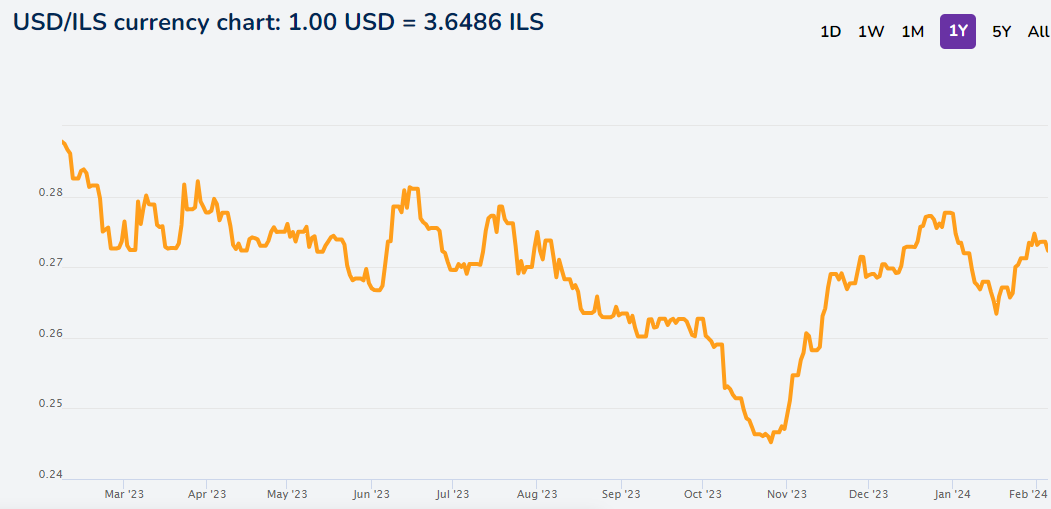
Source: https://www.xe.com/
But beware of shekel rigging by the Israeli government and the Jewish diaspora in the US! This is how it was done in the very first days, primarily by Israel’s Central Bank.
Note that in October 2023, options traders saw a near-70% probability that the shekel would weaken to 4 per dollar in a month — a level unseen since 2015 — compared with only an 18% chance the day before the Hamas operation. Intervention has brought the shekel down from a peak of just over 4 to 3.67 this week. The shekel is one of the biggest losers this year among a basket of 31 major currencies tracked by Bloomberg.
The Tel Aviv 35 Index (TA-35) closed on February 1 at 1817.83. This amounts to a recovery from the collapse of stock value in the first four weeks of the Hamas operation, when the index hit a low of 1605.20 on October 26. While this market is also easy for the Israeli government and the diaspora to rig, the rise in value indicates how much confidence has been generated by the Israel Defence Forces operations in Gaza, and by market sentiment that Israeli is winning its war against Hamas; genocide has been positive for the shekel and for the TA-35.
TRAJECTORY OF ISRAELI STOCK MARKET PRICE INDEX, TA-35
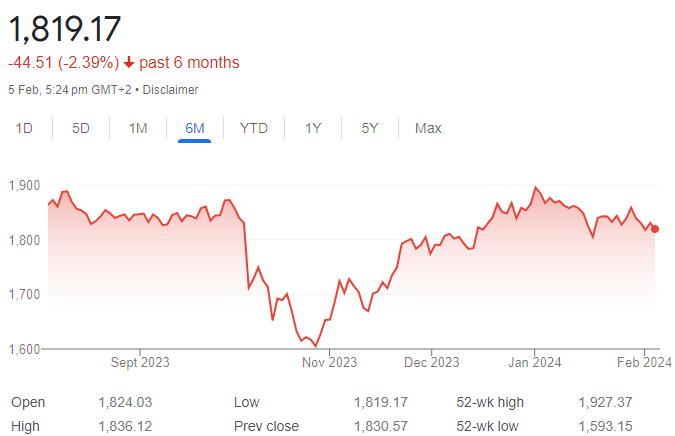
Source: https://www.google.com/
The Israeli bond market is heavily dependent on US state and local governments for 75% of their issue (about $150 million out of a total issue of $200 million) as of last October. This isn’t a bond market as traders understand it, because US government policy, backed by the media, and enforced by the Israel lobby and Jewish communities around the US, ensure there is no loss of confidence in the value to maturity of the bonds. This is market rigging with a difference – it is religious and ideological, as well as political. Even in the relatively short history of the Vatican banks, there has never been a time or an example of an international religion, combined with state governments and their military forces, to insist that the value of their money is backed by their god, or G-d as they report his spelling. By definition and faith, G-d cannot default; but the Israeli state can.
The Israel 5-year sovereign credit default swaps (CDS) are measured and reported to indicate market sentiment on the likelihood of a default, and the premium required for upfront payment in case default occurs. In recent time this reached a maximum value in early 2009. The immediate impact of the start of war last October was the small uptick visible in the chart and the flat line from then until mid-January. Since then, however, with the growing demonstration of the Ansarallah (Houthi) capacity to blockade Israeli shipping in the Red Sea and Gulf of Aden, the increase of operational strikes on the northern (Hezbollah) front, and the impact of new Arab and Iranian offensive operations in the west (Syria, Iraq, Jordan), the perception of default risk has been returning to the October peak.
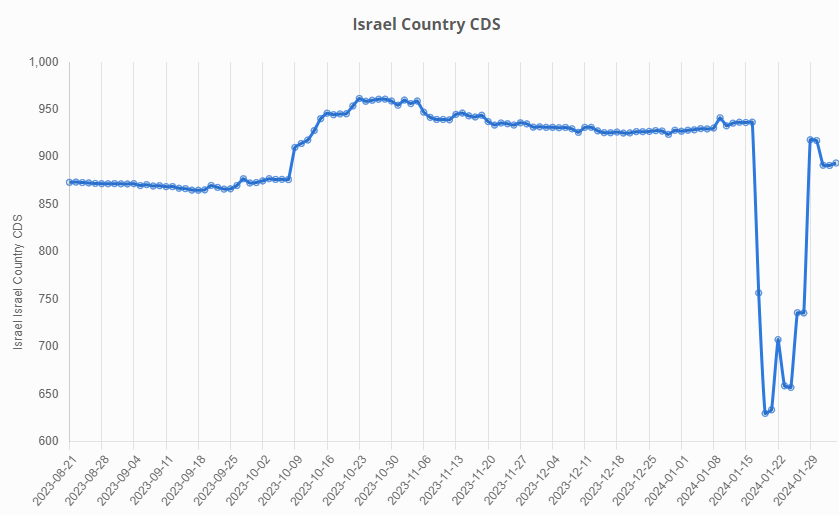
Source: https://macrovar.com/
Reaction to these charts and values on the part of the international ratings agencies has been, first to put Israel debt issues on negative outlook, and then, second, on downgrades. Negative ratings from the agencies raise the cost of servicing Israel’s state and corporate bonds, and put pressure on the state budget. A ratings downgrade is a signal to the markets to go negative against the issuer – this usually follows a change in trader sentiment.
In Israel’s case, however, there has been an exceptional delay between negative outlook and downgrade. The last Fitch report on Israel was dated October 17; Moody’s followed on October 19; Standard & Poors (S&P) on October 24. There has been no new ratings report from Fitch, Moody’s, and Standard & Poor’s since then.
This indicates that enormous pressure is being applied to the ratings agencies and individual analysts not to notice the steady deterioration of the IDF’s military positions in Gaza and Lebanon; the collapse of shipping into and out of the port of Eilat; and the escalation of the regional war against US bases supporting Israel, including US and allied military operations around the Arabian peninsula, bombing and missile attacks across Syria and Iraq.
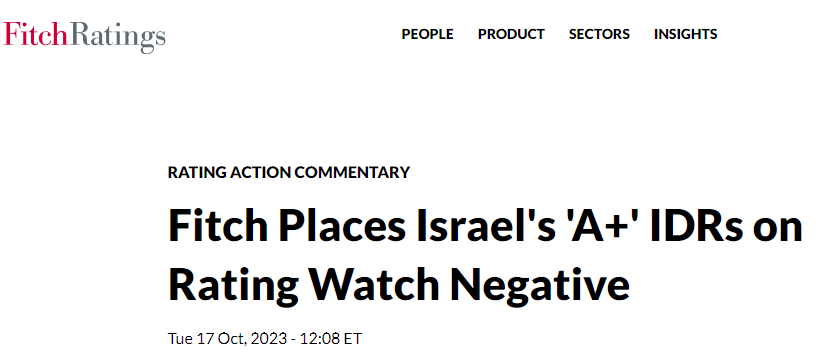
Source: https://www.fitchratings.com/
For analysis of the rating reports in October, click to read.
Reuters and the Israeli press have reported that Israel acknowledged a budget deficit of 22.9 billion shekels in October, a leap from 4.6 billion in September; this pushed up the budget deficit over the prior 12 months to 2.6% of the country’s Gross Domestic Product (GDP). The deficit should increase as war damage accumulates. According to Reuters reporting in December, Israeli officials were admitting then it was “not possible to plan for the possibility that the war against Gaza’s Palestinian Hamas Islamists would stretch into March or beyond.”
By the end of December, the budget deficit had risen to 4.2% of GDP. By the end of January, the projection for this year had risen to 6.6%.
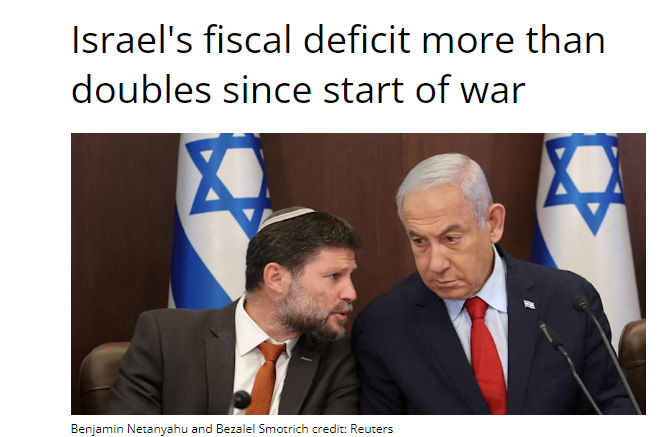
Bezalel Smotrich, left, is Israel’s finance minister. Source: https://en.globes.co.il/
ISRAEL’S BUDGET DEFICIT AS PERCENTAGE OF GDP
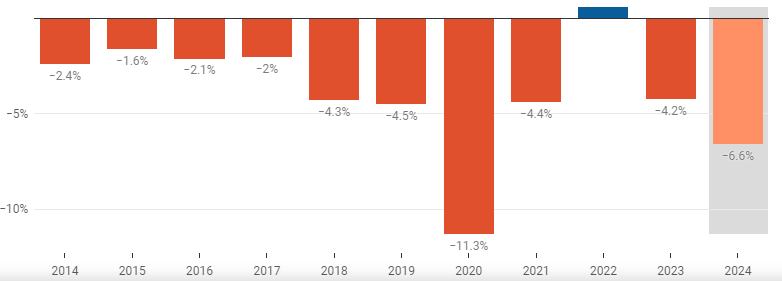
The all-time negative budget deficit/GDP ratio was recorded at 16.1% in 1981. Source: https://tradingeconomics.com
As real estate and other tax collections collapse, Israel will have to make a large cash call on the US. This is going to come in the near future, just as the government in Kiev has been forced into calling on Congress as the Ukraine war is being lost. The longer both wars are protracted, the more obviously the loss of confidence expresses itself in the US Congress.
The Axis of Resistance retains its military capacities for escalation on all fronts. But for the time being, the Arab states and Turkey have yet to introduce a blockade of their export shipments to Israel, and back a worldwide boycott along the lines of the anti-apartheid campaign against South Africa from 1959 until 1994.
ARAB STATE AND TURKISH GROWTH OF TRADE WITH ISRAEL SINCE 2020

Source: https://thecradle.co/
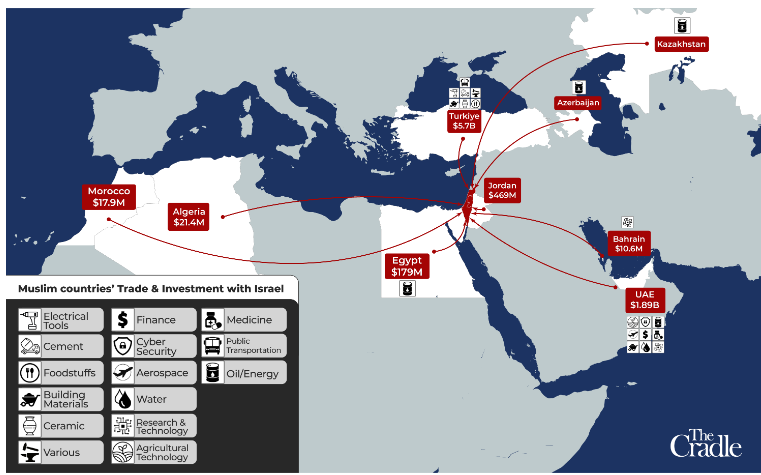
Source: https://thecradle.co/
 And so it comes to pass that the war of attrition is not just between Israel and the Palestinians, but between Israel and the US and the Arab states, Iran and the Islamic states. The extent of the battlefield is only now taking shape.
And so it comes to pass that the war of attrition is not just between Israel and the Palestinians, but between Israel and the US and the Arab states, Iran and the Islamic states. The extent of the battlefield is only now taking shape.


I find the second part very informative and plausible.
Rating agencies are keeping mum to avoid exposing how vulnerable the Israeli economy is.
What is not stated is how difficult it will be, in the current economic conditions, for Israel to dig itself out of the hole. The IDF will need all the youth it can get for many more months. If the northern front opens, for years. Bringing in 75,000 farm and industrial laborers will not solve the problem. The Red Sea is out of bounds for years.
A mass exodus of youth to the US and Europe should be expected after the war.
A genocide ruling by the ICJ will make it very difficult for the European Union to trade with Israel. There will have to be reparations for Gaza. All in all, Israel’s economic and financial woes are unprecedented and only just getting started.
I agree with you that the Russian Ruble is no haven. Putin has not been able to de-offshore and de-dollarize the economy. Russian businesses and HNIs keep their reserves offshore. It used to be Switzerland, London, Cyprus, and now Dubai. You are also right; Russia has never been a hot FDI destination. Only murky hedge funds profited there, and all Russian oligarchs converted their Rubles and parked them abroad.
In those terms, the Shekel might yet prove to be more resilient and a stronger currency than the Ruble. Now, the Russian Central Bank has RMB and INRs, which they are selling at a huge discount for USD, AED, and EURs, keeping it stashed in Dubai and Abu Dhabi.
Given its size, the Israeli value-add economy might yet outperform Russia’s peacetime economy.
I neglected to point out in my intro that rating agencies are ALWAYS slow to downgrade. They pretty much don’t until the bonds are already trading at a price consistent with the deserved lower rating. They validate rather than lead.
However, what I do not know for sovereign credits is how long that cycle typically runs.
Thanks for this- I was mistaken that the delay in downgrade was political.
Curious what ratings will do if ICJ rules against Israel.
US and European Institutional investors can’t buy treasuries of a state convicted of crimes against humanity, can they?
They should stop buying now with the weight of evidence plastered all over.
more like Israelis took themselves and their money out of the country en masse
Yes. Perhaps the hundreds of thousands of seculars sitting on the fence during the protests against likud last year decided Oct 7 was the last straw and left, converting shekels to $. Their departure would likely have helped solidify likud’s majority. Many of these were probably tech workers whose presence will be missed when the war ends. And even those that haven’t left because of feelings of loyalty might also leave after the emergency is over – or if/when it gets worse.
Thank you, Yves.
I echo your (introductory) thoughts, especially as I support my bank employer’s markets and commodities trading / clearing desks, and briefly worked for HSBC in Russia (mid noughties).
I have two meetings next week with IMF and Bank of England officials, so may have tidbits to report.
In a comment yesterday I asked for info on the state of the Israeli economy. No doubt a coincidence, but thanks, and that includes Dawittel.
The pressures on the Israeli economy must be enormous. The amount of cargo going into Israeli ports has shrunk dramatically and last I heard they were preparing to lay off workers there. Then there is the cost of supporting the 100,000 plus people that were evacuated from the northern border with Lebanon. I would hate to think how many billions that would have cost so far. Tourism is a bust of course as few people want to go to a country in the middle of a war much less a genocide. And you can bet that there would be a lot of secular Israelis who are wondering if it would be safer for themselves and their families to emigrate. Then there are all those people in uniform who are now no longer in a productive workforce. There is also the sheer cost of this war and all the billions of dollars in equipment that has been lost in Gaza as well as the northern border. That $17 billion promised to Israel by Congress is starting to sound like chicken feed at the moment. Even if western ratings agencies are treating Israel’s figures as radioactive what happens if a Chinese rating agency put out a realistic assessment? It may turn out that the Israeli economy is as resilient as the Israeli army and that is not a confidence builder that.
> And you can bet that there would be a lot of secular
> Israelis who are wondering if it would be safer for themselves and their families to emigrate.
Some data (i.e., anecdote). I know some Israelis who moved to the EU to wait out the defeat of Hamas. After a few weeks, they returned, because of the antisemitism they encountered. I didn’t ask if they meant the dictionary definition or the IHRA “Working (sic) definition”. The main point is that Israelis are getting the message that it’s a scary place out there, which may discourage emigration.
“The Axis of Resistance — that’s the Arab militaries with Iran and in the background, Russia …”
Strange way of putting it. If we suppose that “militaries” is a mistake for “militias” it makes a bit more sense, since many Arab militaries are combating these same militias. But again, we mean some Arab militias, since “Axis of resistance” as used by Iran is technically limited to Shia militias in Iraq, Syria and Lebanon, combating Israel and by extension the US. As we discussed yesterday, Iran has a relationship with the Houthis, but it’s a complicated one, and was originally intended to make trouble for Saudi Arabia. And the Russians, well, they are ambiguous about Muslim (not necessarily Arab) militias, for obvious reasons.
This isn’t nit-picking. It’s important to understand that the “Axis” is as much a propaganda and political label as anything: there is little central coordination, and it’s not some kind of grand alliance against the US and Israel. In the first place it’s an expression of Iranian foreign policy, and probably all of its “members” would have a different interpretation of it, as well as different, if overlapping, objectives.
“there is little central coordination, and it’s not some kind of grand alliance against the US and Israel.”
That makes it to be more resilient I would think. And it is the west that is inclined to emphasize grand alliances, that ultimately want to cower everyone under the same idea, in a march of lemmings. The “Axis of Resistance”, by their own deeds, from their own volition demonstrate and find themselves to have a common cause. Not much squabbling there. While the West, oh by god, you have a smorgasboard of things thrown together – a very rickety alliance if you ask me.
“ The Israeli bond market is heavily dependent on US state and local governments for 75% of their issue (about $150 million out of a total issue of $200 million) as of last October. This isn’t a bond market as traders understand it, because US government policy, backed by the media, and enforced by the Israel lobby and Jewish communities around the US, ensure there is no loss of confidence in the value to maturity of the bonds. This is market rigging with a difference – it is religious and ideological, as well as political.”
Who knew! Yesterday I came across this report of the arrests of 200 pro-Palestinian protestors at the Pennsylvania state capitol. They were protesting the purchase by the state of Israeli bonds. I read last year a report of NY state’s purchase of Israeli bonds as well. https://www.timesofisrael.com/liveblog_entry/200-arrested-at-pro-palestinian-protest-in-pennsylvania-state-capitol/
By 1984 inflation was reaching an annual rate close to 450% and projected to reach over 1000% by the end of the following year. The economic crisis created feelings of anxiety, confusion, and lack of trust in the government among the Israeli citizens.
It was not until the implementation of this wider-scale stabilization plan, which brought together all the main players in the Israeli economy at the time (the government, labor unions, and the central bank) that inflation was successfully brought to under 20% in less than two years. Some of its main points included:
Curbing the Bank of Israel’s ability to print money to cover government deficits.
https://en.wikipedia.org/wiki/1985_Israel_Economic_Stabilization_P
~~~~~~
Countries that have gone through hyperinflation episodes, tend to be repeaters.
You figuring that the Israelis will let the money printers go brrrrrrrr to cover their deficits and let the inflation wipe away their debts? I could see that.
I can’t imagine the us would let israel get into financial difficulties. 60b for Ukraine and 17b for israel would go to 0 and 77b for israel in a heartbeat. Or any higher number.
Imo the real problem, the one the us can’t do much about, is the pressure from the resistance. Israel as the aircraft carrier anchored in the perfect location implies the surrounding bases are the smaller ships that provide critical protection for the carrier. Evacuation of those bases would leave israel vulnerable, so I can’t see the us doing that no matter who is president.
But meanwhile the carrier is taking on water from hamas’ internal sabotage, and the bases are being harassed unmercifully.
The fence sitting Arab countries are watching with great interest as the us weakens globally and israel looks increasingly vulnerable. Imo Jordan is the key, it was interesting they pushed back on just which base suffered the casualties. Their large Palestinian population may be an influencer, plus Israeli talk of a greater israel between the Euphrates and the Nile.
Boycott! Divest! Sanction!
Let them pay for their genocide war hysteria. It’s up to you – Genocide Joe is all in, more’s the pity. Make him and his corrupt party pay also. What a disgrace our criminal government is.
In fairness to Jon Helmer, he states “The writer of this primer and money-market assessment has requested anonymity to protect against retaliation from the US, Israel or their allies.” and, like I, may not be super qualified to evaluate editorially – hence thanks for the intro.
The choice of 2020 as a base year to look at trade growth, given Covid19, is clearly a bias that, had I been editor, I would have insisted be moved back a few years.